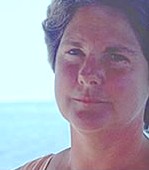
This web page is part of the Michigan Today Archive. To see this story in its original context, click here.
|
From Mad Mary Lamb: Mad Mary Lamb: Lunacy and Murder in Literary Londonby Susan Tyler Hitchcock '70, '71 MA, was a February Book-of-the-Month pick (W. W. Norton, $24.95 hardcover). The story of murder and madness in the life of Mary Lamb, author with her brother, Charles, of the famous children's classic Tales of Shakespeare, was praised as a "pleasurably solid and fascinating piece of work" by the author Bill Bryson. Michigan Today News-e began an interview with Hitchcock by asking her to describe her subject. Hitchcock: Mary Lamb was a writer, one of the older generation of English Romantics. She is best known as co-author with her brother Charles of Tales from Shakespeare, the children's classic published in 1807 and still in print today. She and Charles also wrote two other children's books. Mary wrote the majority of all three, as Charles himself admitted, yet she has remained a footnote in the literary history of his better-known essays and poems. Why has she received little attention as an author? First of all, those times made it difficult for women to gain recognition. Their role was domestic and supportive. But Mary Lamb had a more personal reason. In 1796, ten years before writing Tales from Shakespeare, in a fit of irrational rage, Mary Lamb stabbed her mother to death with a kitchen knife. She didn't go to jail? The very night she committed the matricide, her brother Charles took her to a small private madhouse outside London. When, as the law dictated, a coroner and his jury arrived the next day to examine the body and determine the cause of death, they declared the murder an act of lunacy. Charles Lamb, then 21, promised to act as guardian to his sister, herself 31, and indeed they did live together for the rest of their lives in what Charles once called "a double singleness." She wasn't put in a mental institution? Mary's older brother wanted her in London's famous Bethlem Hospital—a mental institution so chaotic that its name became our word 'bedlam.' But Charles saw to it that Mary received compassionate care. Through the next 20 years she occasionally needed madhouse treatment but otherwise lived a normal life with Charles. Their London home became the center of a lively circle of poets, artists, and philosophers, including Samuel Taylor Coleridge, William and Dorothy Wordsworth (also brother and sister), and William Hazlitt. Where did your interest in Lamb begin? As an Honors English student at the University of Michigan, I became fascinated with the Romantics, then wrote a master's thesis on their philosophical harmonies with medieval alchemy. I have published ten nonfiction books since then, on topics far and wide—gathering edible wild plants, a sailing trip with my family, the history of the University of Virginia—but now, with Mad Mary Lamb, I return to the intellectual love of my college years. What a pleasure! |
|
Michigan Today News-e is a monthly electronic publication for alumni and friends. |
| MToday NewsE | |
|
|
Michigan Today
online alumni magazine
University Record
faculty & staff newspaper
MGoBlue
athletics
News Service
U-M news
Photo Services
U-M photography
University of Michigan
gateway
 At that moment, a young man burst in through the door. Pushing past the landlord, he cried out, "Good God! Mary! What has happened here? Why?" Then, quickly, Charles Lamb reached around from behind his sister, taking hold of the knife in her right hand. She succumbed to his grasp and gave up the weapon willingly. In that moment, she rested in his strength. Gently, he seated her in one of the dining chairs she had just arranged. The joint of meat meant for dinner sat untouched in the middle of the table. The gravy had started to coagulate. Gray turnip globes sat trapped in a thin white sheet of fat.
At that moment, a young man burst in through the door. Pushing past the landlord, he cried out, "Good God! Mary! What has happened here? Why?" Then, quickly, Charles Lamb reached around from behind his sister, taking hold of the knife in her right hand. She succumbed to his grasp and gave up the weapon willingly. In that moment, she rested in his strength. Gently, he seated her in one of the dining chairs she had just arranged. The joint of meat meant for dinner sat untouched in the middle of the table. The gravy had started to coagulate. Gray turnip globes sat trapped in a thin white sheet of fat. 